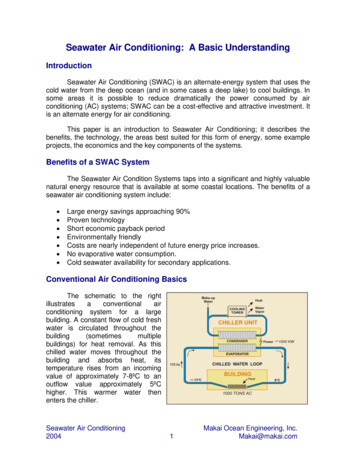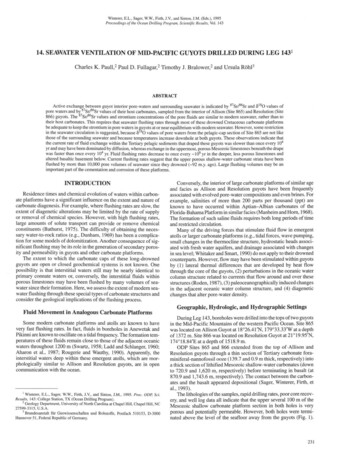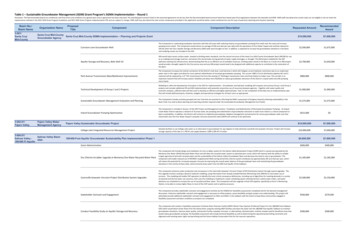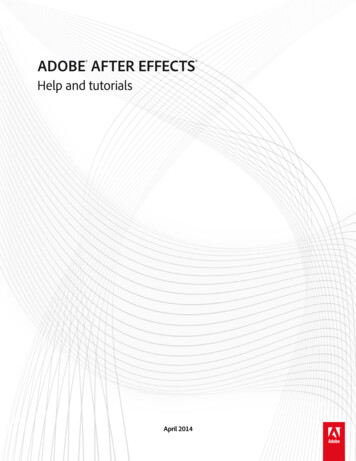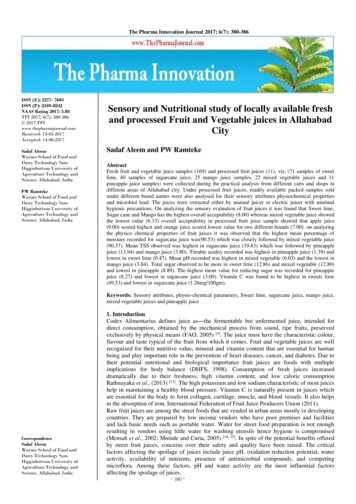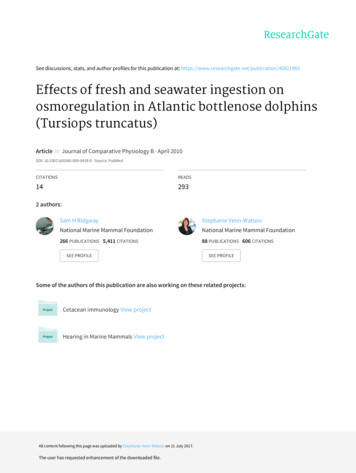
Transcription
See discussions, stats, and author profiles for this publication at: ffects of fresh and seawater ingestion onosmoregulation in Atlantic bottlenose dolphins(Tursiops truncatus)Article in Journal of Comparative Physiology B · April 2010DOI: 10.1007/s00360-009-0439-0 · Source: PubMedCITATIONSREADS142932 authors:Sam H RidgwayStephanie Venn-WatsonNational Marine Mammal FoundationNational Marine Mammal Foundation266 PUBLICATIONS 5,411 CITATIONS88 PUBLICATIONS 606 CITATIONSSEE PROFILESEE PROFILESome of the authors of this publication are also working on these related projects:Cetacean immunology View projectHearing in Marine Mammals View projectAll content following this page was uploaded by Stephanie Venn-Watson on 21 July 2017.The user has requested enhancement of the downloaded file.
J Comp Physiol BDOI 10.1007/s00360-009-0439-0ORIGINAL PAPEREVects of fresh and seawater ingestion on osmoregulationin Atlantic bottlenose dolphins (Tursiops truncatus)Sam Ridgway · Stephanie Venn-WatsonReceived: 26 May 2009 / Revised: 8 December 2009 / Accepted: 11 December 2009 Springer-Verlag 2009Abstract Bottlenose dolphins (Tursiops truncatus) aremarine mammals with body water needs challenged by little access to fresh water and constant exposure to saltwater. Osmoregulation has been studied in marine mammals for a century. Research assessing the eVects ofingested fresh water or seawater in dolphins, however, hasbeen limited to few animals and sampling times. Nine16- to 25-h studies were conducted on eight adult dolphinsto assess the hourly impact of fresh water, seawater, andseawater with protein ingestion on plasma and urine osmolality, urine Xow rate (ufr), urinary and plasma soluteconcentrations, and solute clearance rates. Fresh wateringestion increased ufr. Fresh water ingestion alsodecreased plasma and urine osmolality, sodium and chloride urine concentrations, and solute excretion rates. Seawater ingestion resulted in increased ufr, sodium, chloride,and potassium urine concentrations, sodium excretion rates,and urine osmolality. Seawater with protein ingestion wasassociated with increased ufr, plasma osmolality, sodiumexcretion, and sodium, chloride, potassium, and urea urineconcentrations. In conclusion, bottlenose dolphins appearto maintain water and plasma solute balance after ingestingCommunicated by I. D. Hume.S. Ridgway (&)Department of Pathology, School of Medicine,University of California San Diego, 9500 Gilman Drive,Mail Code 0679, La Jolla, CA 92093, USAe-mail: sam.ridgway@nmmpfoundation.orgS. Ridgway · S. Venn-WatsonNavy Marine Mammal Program Foundation,1220 Rosecrans St. #284, San Diego, CA 92106, USAS. Venn-Watsone-mail: stephanie@epitracker.comfresh water or seawater by altering urine osmolality andsolute clearance. Ingestion of protein with seawater appearsto further push osmoregulation limits and urine solute concentrations in dolphins.Keywords Dolphin · Marine mammal · Osmoregulation ·Fresh water · SeawaterAbbreviationsHPTR High protein test rationMMP Navy Marine Mammal ProgramIntroductionBottlenose dolphins (Tursiops truncatus) are secondarymarine inhabitants with ancestors that lived in terrestrialenvironments (Shimamura et al. 1997; Thewissen andMadar 1999). As such, adaptations that dolphins and othermarine mammals have developed to live in saltwater withlittle to no access to fresh water have been of interest torenal physiologists for a century. Marine mammals havebeen characterized as good osmoregulators, and bottlenosedolphin urine osmolality and urine to plasma osmolalityratio have been previously reported as 1,815 mOsm/kg and5.3, respectively (Ortiz 2001; Malvin and Rayner 1968).The water concentrating capability of dolphins and othercetaceans appears to be better than humans and their closeancestral relatives, cattle, but not as eVective as other mammals, including the domestic cat and hopping mouse (Vander1995; Birukawa et al. 2005; Schmidt-Nielsen 1990).Reports from the early twentieth century initially indicated that marine mammals did not ordinarily drink seawater (Fetcher 1939). More recent literature, however, hasdemonstrated that some marine mammals ingest small123
J Comp Physiol Bamounts of seawater, including Weddell seal pups, harpseals, and bottlenose dolphins (Tedman and Green 2009;How and Nordøy 2007; Hui 1981; Telfer et al. 1970). Seaotters routinely drink seawater (Costa 1982), and ingestionof both fresh and seawater has been reported in captive harpseals (Gales and Renouf 1993; Renouf et al. 1990). Coastalbottlenose dolphins may swim into fresh water rivers(Caldwell and Caldwell 1972).While fresh water ingestion may be a rare concern formost wild dolphins, managed collections of dolphins maybe more likely to be exposed to fresh water sources. Further, fresh water may be provided intentionally to dolphinsfor therapeutic purposes, including management of renaldisease or response to suspected dehydration.Limited studies have assessed the impact of fresh water,seawater, and protein ingestion on cetacean osmoregulation. After feeding tap water to an adult bottlenose dolphin,urine osmolality appeared to remain at a steady state for 2 hfollowing ingestion, and diuresis did not occur (Malvin andRayner 1968). Hyperosmotic Xuid infusion via stomachtube, however, did demonstrate diuresis in bottlenose dolphins (Fetcher and Fetcher 1942). Estimated glomerularWltration rate was higher in dolphins that were recently fedcompared to those that were fasted overnight (Venn-Watsonet al. 2008), and Ortiz et al. (2009) recently reported nosigniWcant eVect of feeding on plasma osmolality. In theOrtiz et al. study (2009), there were also no signiWcant postfeeding changes in plasma sodium concentrations. Basedupon dramatically higher plasma and urine urea levels incetaceans compared to cattle, it has been hypothesized thatcetacean osmoregulation mechanisms may be stronglyassociated with diet (Birukawa et al. 2005).Extensive research has been conducted on seals and sealions to characterize marine mammal osmoregulatoryresponses to fresh water and seawater challenges. Increasedurine Xow rate and decreased urine osmolality have beenreported in seals and sea lions challenged with fresh waterinfusions, and increased Xow rate and increased sodium andchloride excretion have been reported following hypertonicsaline ingestion or infusions (Albrecht 1950; Bradley et al.1954; TarasoV and Toews 1972; Hong et al. 1982; Skogand Folkow 1994; Storeheier and Nordøy 2001; Ortiz et al.2002). Both fresh and seawater infusions increased urinevolume in harbor seals (TarasoV and Toews 1972), andinfusion of hypertonic saline in Northern elephant sealsresulted in increased glomerular Wltration rate and urineoutput (Ortiz et al. 2002, 2003).To better assess the impact of fresh water, seawater, andseawater with protein ingestion on osmoregulation in dolphins, nine 16- to 25-h urine and blood collection studieswere conducted on eight adult bottlenose dolphins. Asdemonstrated in other marine mammals, we hypothesizedthat ingestion of fresh water would increase urine Xow rate123and decrease urine osmolality and solute excretion; ingestion of seawater would increase Xow rate, urine osmolality,and solute excretion; and addition of protein with seawatermay have an additive impact on osmoregulation, includingdiuresis.Materials and methodsThe Navy Marine Mammal Program (MMP) is accreditedby the Association for Assessment and Accreditation ofLaboratory Animal Care International and adheres to thenational standards of the United States Public Health Service Policy on the Humane Care and Use of LaboratoryAnimals and the Animal Welfare Act. As required by theDepartment of Defense, the MMP’s animal care and useprogram is routinely reviewed by an Institutional AnimalCare and Use Committee and the Navy Bureau of Medicine.Experimental studyEight dolphins employed in the study were all adult Tursiops truncatus that were healthy at the start of the study asdetermined by behavior, appetite, and clinical blood values(Ridgway et al. 1970). All animals were fasted 12 h overnight before the start of each study. The animals were takenfrom their seawater habitat in a Xeece-lined transport sling(Fig. 1). They were placed on their sides on a soft rubberpad. An initial blood sample was taken from the centralvessels of the Xuke (Ridgway 1965). A standard 8–14 Frclinical urinary catheter with inXatable cuV was insertedthrough the urethra into the urinary bladder. The cuV wasinXated with 15–20 mL of sterile normal saline to retain thecatheter in the bladder throughout the study. An initialFig. 1 The dolphin is lifted in a Xeece-lined sling in preparation forthe experiment
J Comp Physiol Burine sample was taken and the collection end of the catheter was pulled through a small central hole in the transportsling and connected to a length of tubing. The dolphin wasthen lifted into a transport container that had been partiallyWlled with seawater (34 parts per thousand salinity) fromthe dolphin’s home pool. The level of seawater in the container was suYcient to keep the water surface just above thelevel of the dolphin’s eyes (Fig. 2). During the experiment,seawater was poured or sponged over the dorsal portion ofthe animal to prevent drying. The catheter tubing was connected through a port in the dolphin transport container andinserted into a urine collection vessel.Sample collectionBlood and urine sample collections were conducted everyhour over a desired 24–25 h. In some cases, issues related tocatheter placement or animal comfort did not enable studiesto persist for the full 24–25 h; the shortest studies (n 3)lasted 16–17 h. A description of the duration and challengeof each study is provided (Table 1). For blood collection, thedolphin’s Xukes were carefully lifted free of the water forobtaining blood samples of approximately 20 mL using asterile 20 gauge disposable hypodermic needle. At hourlyintervals, the urine collection vessel was emptied, measured,and an aliquot saved in a standard urinalysis vial.Blood and urine diagnosticsStudy plasma and urine variables included urea (mg/dl),sodium (mEq/L), chloride (mEq/L), potassium (mEq/L),and osmolality (mOsm/kg). Plasma and urine glucose(mEq/L) were measured during the fasting studies and thestudy involving seawater with protein ingestion. Specimenswere stored at 4 C. Periodically, plasma was collected fromeach heparinized blood tube after cells had settled. Plasmaand urine were transported to a clinical laboratory experienced with dolphin specimens (Bioscience Laboratories,Van Nuys, California) for analysis. The following methodologies were employed: plasma urea, Autoanalyzer(Technicon SMA-12, Technicon Corp. Ardaley, NY); urineurea, modiWed urease and Berthelot method; sodium andpotassium, Xame photometry (Instrumentation Laboratory,Inc., Waterman, MS.); chloride, Buchler–Cotlove chloridometer (Buchler Instruments, Inc., Fort Lee, NJ). Urineand plasma osmolality were measured by freezing pointFig. 2 During urine and bloodcollection, the dolphin restsin a container of sea wateras depicted hereTable 1 Descriptions of nine studies among eight bottlenose dolphins (Tursiops truncatus)StudynumberStudy typeTotalhoursStudy dateAnimal IDPlasmasamples (#)Urinesamples (#)1Fasting1601 MayA14132Fasting2425 NovemberB16153Fresh water (2 L)2520 MarchC5254Fresh water (4 L)2520 MarchD5255Fresh water (4 L)2104 AprilB2216Sea water (3 L)2426 MarchE10247Sea water (2 L) mackerel (10.5 lb)2226 MarchF9208Sea water HPTR (4 L)1601 MayG13139Sea water HPTR (4 L)1701 MayH1316123
J Comp Physiol Bdepression with a Fiske osmometer (Advanced InstrumentsInc., Norwood, MA).ResultsDescriptive analysesClearance rates, excretion rates, and urine to plasmaosmolality ratiosClearance and Wltration rates were calculated using the following equations: hourly urine Xow rate (mL/min) (totalmL urine/h)/60. Clearance rates for sodium, chloride,potassium and urea (mL/min) [urine concentration ofsubstance (mEq/L) urine Xow rate (mL/min)]/plasmaconcentration of substance (mEq/L). Hourly excretion ratesof solutes were calculated as mEq/min [total urinary solute (mEq)/60]. Urine to plasma osmolality ratio urineosmolality/plasma osmolality.Feeding trialsA total of nine feeding trials were conducted via stomachtube with eight adult bottlenose dolphins (Table 1). Onedolphin (Animal B) participated in two feeding trials; thesetrials were conducted several months apart. The Wve feeding trial categories were fasting (last 16–23 h of a 36 h fasting period); 2–4 L deionized water; 3 L seawater; 2 Lseawater with 4.8 kg mackerel; and 4 L seawater with 4 kghigh protein test ration (HPTR). The HPTR was made inour laboratory and had been successfully fed to dolphinsand sea lions (Van Dyke 1972). Each kilogram of HPTRconsisted of the following ingredients: Wsh protein concentrate (100 g), Fish meal (100 g), gelatin (40 g), lard (65 g),cottonseed oil (15 g), sodium alginate (9 g), sodium tripolyphosphate (3 g), and 668 g water. Total protein, 17.6%,68% water, carbohydrate content was negligible. By comparison mackerel contained 18.2% protein, 75% water andalso negligible carbohydrate.StatisticsData were analyzed using SAS software (Release 9.2;SAS Institute, Inc., Cary, NC). Mean and standard error ofthe mean (SEM) values were determined for urine Xowrates, plasma and urine osmolalities, urine to plasma osmolality ratios, and urine concentrations, urine clearance rates,and serum levels for sodium, chloride, potassium, and urea.Within each study group, changes in urine and plasma values over time were assessed by comparing mean valuesamong the following time categories: 0–5 h, 5–10 h, 10–15 h, and 15 h. An one-way analysis of variance with ageneral linear model was used with post hoc comparisonsamong each of the time categories (PROC GLM; CLASSTIMECATEGORY; MODEL [serum and urine variables] TIMECATEGORY; MEANS TIMECATEGORY/SCHEFFE; BY STUDY TYPE).123Maximum values recorded for urine Xow rate, plasmaosmolality, urine osmolality, and urine to plasma osmolality ratios were 8.2 mL/min, 378, 2,658 mOsm/kg, and 7.3,respectively. The maximum urine concentrations ofsodium, chloride, potassium, and urea were 1,706, 2,222,351, and 110 mEq/L, respectively. Maximum clearancerates for sodium, chloride, potassium, and urea were 24.1,42.7, 292, and 200 mEq/min, respectively. Minimum andmaximum sodium, chloride, potassium, and urea plasmalevels were 141–168, 102–127, 2.8–4.9, and 27.5–65 mEq/L,respectively. In-house serum reference ranges for thesevariables are 152–158, 115–125, 3.4–4.1, and 36–59 mEq/L;it is important to note that these reference ranges are forserum, not plasma, and were established from routine samples submitted to a diVerent reference laboratory usingdiVerent equipment than that used in the present study.Group comparisons and fastingA comparison of mean § SEM plasma and urine valuesamong the Wve study groups is provided in Table 2. Whilethese comparisons are interesting, interpretation is limitedby the fact that only one to two animals were used for eachstudy, and inter-animal variation could not be controlled.Comparisons of measured blood and urine values duringthe last 24 h of 36 h of fasting are provided in Table 3.Fresh water ingestionAfter ingestion of 2–4 L of fresh water, urine Xow rate wassigniWcantly higher during the Wrst 15 h after ingestion(2.5–2.9 mL/min) compared to more than 15 h after ingestion (1.6 § 0.1 mL/min; P 0.0009) (Table 4). Plasmaosmolality was lowest 15 or more hours after ingestion(319 § 4 mOsm/kg) compared to the Wrst 5 h (341 § 5mOsm/kg) (P 0.01), and decreases in urine osmolalitywere detected at 6–10 h as well as more than 15 h afteringestion (736 § 32 and 747 § 41 mOsm/kg, respectively;P 0.008). No changes in the urine to plasma osmolalityratio were noted during 24 h post ingestion (P 0.21).There were no statistically signiWcant changes in plasmasodium levels during 24 h post ingestion (P 0.3). Plasmachloride was signiWcantly lower 15 h or more post ingestioncompared to the Wrst 5 h (119 § 2 and 106 § 1 mEq/L,respectively; P 0.003). At greater than 5 h post ingestion,both sodium and chloride mean plasma levels went belowthe normal reference ranges for this population (normallow limit of sodium 152 mEq/L, normal low limit ofchloride 115 mEq/L, Venn-Watson et al. 2007).
J Comp Physiol BTable 2 Comparisons of mean values § SEM for selected blood and urine values of hourly samples from bottlenose dolphins (Tursiops truncatus) by study group (9 studies, 8 animals)VariableMean value § SEMFastedDeionized waterSeawaterMackerel seawaterHPTR seawaterUrine Xow rate (mL/min)0.8 § 0.12.3 § 0.21.8 § 0.42.1 § 0.43.1 § 0.2Plasma osmolality (mOsm/kg)335 § 2328 § 4336 § 2346 § 7338 § 21,295 § 53813 § 301,794 § 481,670 § 372,129 § 503.8 § 0.22.8 § 0.35.0 § 0.35.0 § 0.26.2 § 0.144 § 628 § 8370 § 87258 § 78710 § 63151 § 1150 § 2160 § 1161 § 2153 § 1Urine osmolality (mOsm/kg)Urine:plasma osmolality ratioSodiumUrine concentration (mEq/L)Plasma (mEq/L)ChlorideUrine concentration (mEq/L)567 § 114323 § 77915 § 83110 § 1113 § 2112 § 1112 § 3116 § 1Urine concentration (mEq/L)34 § 744 § 652 § 8107 § 14213 § 14Plasma (mEq/L)3.8 § 0.033.5 § 0.13.5 § 0.23.7 § 0.13.7 § 0.1Urine concentration (mEq/L)14 § 218 § 2ND35 § 758 § 5Plasma (mEq/L)43 § 140 § 344 § 445 § 239 § 1Plasma (mEq/L)61 § 666 § 11PotassiumUreaGlucoseUrine concentration (mEq/L)184 § 2212,382 § 3,612Plasma (mEq/L)133 § 2170 § 6Prot-sea, 4L seawater with 4 kg HPTR; mack sea, 10.5 lb Spanish mackerel and 2 L seawater; fresh, 2–4 L deinonized water; sea, 3 L seawater;fast, last 16–23 h of a 36 h fast; ND, not determined or P value could not be calculated due to small numbersUrine sodium and chloride concentrations decreasedafter 15 h post ingestion compared to the Wrst 5 h (urinesodium 8 § 2 vs. 83 § 34 mEq/L, urine chloride 33 § 6 vs.140 § 44 mEq/L; P 0.003). Sodium and chloride excretion rates were higher during the Wrst 5 h post ingestioncompared to greater than 5–24 h (sodium excretion 1.6 § 0.3 vs. 0.6 § 0.1, chloride excretion 2.5 § 0.4 vs.1.0 § 0.1; P 0.0001).Urine potassium concentration was lower 15 h or morepost ingestion compared to the Wrst 5 h (27 § 5 and74 § 20 mEq/L, respectively; P 0.02). There were no signiWcant diVerences in potassium plasma levels or excretionrate during 24 h post ingestion. There were no diVerencesin plasma or urine urea concentrations or urea excretionrate during 24 h post ingestion.Sea water ingestionAfter ingestion of 3 L of sea water, urine Xow rate washigher during the Wrst 5 h after ingestion (4.8 § 0.9 mL/min) compared to more than 5 h after ingestion (0.8–1.6 mL/min; P · 0.0001) (Table 5). There were no changesin plasma osmolality during 24 h post ingestion(P 0.07). Urine osmolality was higher 5 h or more postingestion compared to the Wrst 5 h (1,826–1,931 vs.1,391 § 76 mOsm/kg; P · 0.0001). Urine to plasma osmolality ratio was higher 15 h or more post ingestion compared to the Wrst 5 h (5.8 § 0.1 and 4.1 § 0.3, respectively;P 0.005).There were no changes in plasma sodium or chloridelevels during 24 h post ingestion (P 0.27 and 0.16,respectively). Plasma sodium did exceed normal highlevels, however, during the Wrst 10 h post ingestion (normalhigh limit of sodium 159 mEq/L, Venn-Watson et al.2007).Urine sodium and chloride concentrations were highestduring the Wrst 5 h post ingestion compared to greater than5 h (urine sodium 1,043 § 232 vs. 108–359 mEq/L, urinechloride 1,419 § 318 vs. 225–574 mEq/L; P · 0.0001).Sodium excretion rates were higher during the Wrst 15 hpost ingestion compared to more than 15 h (4.9–6.2 vs.3.8 § 0.2). Chloride excretion was higher during 6–10 hpost ingestion compared to greater than 15 h (9.8 § 0.2 and7.9 § 0.4, respectively; P 0.01).Urine potassium concentration was highest during theWrst 5 h post ingestion compared to more than 5 h(121 § 15 vs. 26–46 mEq/L; P 0.0001) (Table 4). Potassium excretion was highest 10 h or more post ingestioncompared to the Wrst 5 h (0.9–1.0 vs. 0.7 § 0.05, P 0.0003). There were no signiWcant diVerences in potassium123
J Comp Physiol BTable 3 Comparisons of mean selected blood and urine values, by time after feeding challenge, in two bottlenose dolphins (Tursiops truncatus)VariableFasting, mean value § SEMTime 1 0–5 h (n 8)Time 2 5–10 h (n 10)P valueTime 3 10–15 h (n 10)Time 4 15 h (n 9)Urine Xow rate (mL/min)0.8 § 0.10.6 § 0.11.1 § 0.20.8 § 0.20.12Plasma osmolality (mOsm/kg)336 § 4333 § 3334 § 3339 § 10.621,471 § 1131,100 § 841,290 § 671,390 § 880.044.2 § 0.43.1 § 0.33.9 § 0.24.1 § 0.20.11Urine osmolality (mOsm/kg)Urine:plasma osmolality ratioSigniWcantcomparisonsamong timegroups1 2SodiumUrine concentration (mEq/L)72 § 1619 § 538 § 553 § 100.004Excretion (mEq/min)2.2 § 0.30.8 § 0.11.0 § 0.22.3 § 0.2 0.0001Plasma (mEq/L)153 § 1150 § 2149 § 2152 § 11 24, 1 3,20.39ChlorideUrine concentration (mEq/L)78 § 1333 § 772 § 866 § 140.021 2Excretion (mEq/min)2.4 § 0.21.6 § 0.11.7 § 0.22.8 § 0.20.00024 3,2Plasma (mEq/L)109 § 1111 § 1112 § 1108 § 20.13PotassiumUrine concentration (mEq/L)28 § 920 § 975 § 2013 § 50.01Excretion (mEq/min)1.0 § 0.31.4 § 0.41.4 § 0.30.5 § 0.20.373 2,4Plasma (mEq/L)3.8 § 0.13.6 § 0.13.7 § 0.043.9 § 0.030.0613 § 37§121 § 316 § 50.020.04 § 0.010.03 § 0.010.04 § 0.010.03 § 0.010.6440 § 0.542 § 146 § 243 § 10.013 199 § 23173 § 44271 § 44245 § 260.023 1UreaUrine concentration (mEq/L)Excretion (mEq/min)Plasma (mEq/L)3 2GlucoseUrine concentration (mEq/L)Excretion (mEq/min)0.3 § 0.10.6 § 0.10.5 § 0.10.5 § 0.030.022 1Plasma (mEq/L)129 § 4142 § 2133 § 2127 § 40.0082 1,4or urea plasma levels during 24 h post ingestion (P 0.3and 0.06, respectively). Urea excretion was higher morethan 5 h after ingestion compared to the Wrst 5 h (0.03–0.04vs. 0.02 § 0.005, P 0.0001).Sea water and mackerel ingestionAfter ingestion of 2 L of sea water and 10.5 lb of mackerel,urine Xow rate was higher during the Wrst 5 h after ingestion(5.0 § 0.5 mL/min) compared to more than 5 h after ingestion (0.8–1.6 mL/min; P · 0.0001) (Table 6). Plasmaosmolality was highest during the Wrst 5 h post ingestion(358 § 2 mOsm/kg), followed by 6–10 h (337 mOsm/kg);the lowest plasma osmolality occurred after 15 h postingestion (324 § 0.3 mOsm/kg, P 0.0003). There wereno changes in urine osmolality or urine to plasma osmolality ratio during 22 h post ingestion (P 0.09 and 0.57,respectively).Plasma sodium levels exceeded normal high levels(normal high limit of sodium 159 mEq/L) during the Wrst10 h post ingestion and were highest during the Wrst 5 h123compared to greater than 5 h (166 § 0.6 and 159 § 2 mEq/L,respectively; P 0.05). There were no changes in plasmachloride levels during 22 h post ingestion (P 0.44).Urine sodium and chloride concentrations were highestduring the Wrst 5 h post ingestion compared to greater than5 h (urine sodium 798 § 107 vs. 41–158 mEq/L, urinechloride 823 § 132 vs. 108–254 mEq/L; P · 0.0001).Sodium excretion rates were highest during the Wrst 5 hpost ingestion (4.4 § 0.4), followed by 6–10 h post ingestion (2.4 § 0.4), compared to more than 10 h (1.2 § 0.1)(P 0.0001). There were no diVerences in chloride excretion during 22 h post ingestion (P 0.08).Urine potassium and urea concentrations were highestduring the Wrst 5 h post ingestion compared to more than5 h (urine potassium 198 § 22 vs. 68–84 mEq/L, urineurea 80 § 7 vs. 12–31 mEq/L; P 0.0001). Plasmapotassium was lowest after 15 h post ingestion(3.5 § 0.1 mEq/L, P 0.02). Potassium excretion washighest during 10–15 h post ingestion (2.9 § 0.03 vs. 01.1–1.9, P · 0.0001). There were no diVerences in plasma ureaduring 22 h post ingestion (P 0.6).
J Comp Physiol BTable 4 Comparisons of mean selected blood and urine values, by time after feeding challenge, in two bottlenose dolphins (Tursiops truncatus)VariableFresh water, mean value § SEMTime 1 0–5 h (n 10)Time 2 5–10 h (n 10)Urine Xow rate (mL/min)2.9 § 0.62.7 § 0.4Plasma osmolality (mOsm/kg)341 § 5320 § 2Urine osmolality (mOsm/kg)996 § 86736 § 32Urine:plasma osmolality ratio3.4 § 0.52.1 § 0.5P valueTime 3 10–15 h (n 10)2.5 § 0.2820 § 84Time 4 15 h (n 16)SigniWcantcomparisonsamong timegroups1.6 § 0.10.0091 4319 § 40.011 4747 § 410.0081 2,42.6 § 0.30.21SodiumUrine concentration (mEq/L)83 § 3419 § 517 § 58§20.0031 3,4Excretion (mEq/min)1.6 § 0.30.5 § 0.10.5 § 0.10.6 § 0.10.00011 2,3,4Plasma (mEq/L)153 § 3144 § 2150 § 30.30ChlorideUrine concentration (mEq/L)140 § 4463 § 1454 § 1133 § 60.003Excretion (mEq/min)2.5 § 0.41.1 § 0.11.2 § 0.11.0 § 0.1 0.0001Plasma (mEq/L)119 § 2113 § 41 41 2,3,4106 § 10.0031 41 4PotassiumUrine concentration (mEq/L)74 § 2046 § 1040 § 827 § 50.02Excretion (mEq/min)1.3 § 0.11.0 § 0.11.2 § 0.21.3 § 0.20.69Plasma (mEq/L)3.7 § 0.33.2 § 0.43.4 § 0.20.4729 § 920 § 411 § 20.09UreaUrine concentration (mEq/L)Excretion (mEq/min)0.03 § 0.004Plasma (mEq/L)42 § 20.02 § 0.00320 § 30.03 § 0.00439 § 1Sea water and HPTR ingestionAfter ingestion of 4 L of sea water and a high protein testration (HPTR), urine Xow rate was higher during the Wrst10 h after ingestion (3.2–3.9 mL/min) compared to morethan 15 h after ingestion (1.4 § 0.2 mL/min; P 0.001)(Table 7). Plasma osmolality was higher during the Wrst 5 hpost ingestion (346 § 5 mOsm/kg), compared to more than10 h post ingestion (328 mOsm/kg, P 0.0003). Urineosmolality was higher during greater than 5–10 h postingestion (2,328 § 62 mOsm/kg) compared to more than15 h post ingestion (1,789 § 34 mOsm/kg). There were nochanges in urine to plasma osmolarity ratio during 16–17 hpost ingestion (P 0.11).Plasma sodium did not change during 16–17 h postingestion (P 0.09), and plasma chloride was higher during 5–10 h post ingestion compared to greater than 10 h(121 § 1 vs. 112–114 mEq/L, P 0.002). Urine sodiumconcentrations were highest during the Wrst 10 h post ingestion compared to greater than 15 h (763–950 vs.177 § 34 mEq/L; P 0.001). Urine chloride levels werehigher during 5–10 h post ingestion compared to greaterthan 15 h (1,237 § 106 vs. 275 § 50 mEq/L, P 0.005).Sodium and chloride excretion rates were higher during theWrst 15 h post ingestion compared to more than 15 h0.02 § 0.00338 § 70.260.85(sodium excretion 5.8–6.7 vs. 3.6 § 0.3, P 0.0001;chloride excretion 7.8–8.7 vs. 5.5 § 0.2, P 0.003).Urine potassium and urea concentrations were highestduring 5–10 h post ingestion compared to more than 15 h(urine potassium 272 § 20 vs. 110 § 27 mEq/L, P 0.001;urine urea 75 § 5 vs. 19 § 3 mEq/L; P 0.03). Therewere no diVerences in plasma potassium or potassium orurea excretion during 16–17 h post ingestion (P 0.94,0.88, and 0.27, respectively).Clearance ratesClearance rates for sodium, chloride, potassium, and ureaare provided in Table 8. Clearance rates for all solutesappeared lowest during fasting and highest after ingestionof seawater and HPTR.DiscussionIn our study, bottlenose dolphins demonstrated the ability todilute and concentrate urine from 225 to 2,658 mOsm/kg,respectively. The upper limit identiWed in our study washigher than that previously reported in a study involving twobottlenose dolphins fed 25 lb raw Wsh (range 1,322–1,815123
J Comp Physiol BTable 5 Comparisons of mean selected blood and urine values, by time after feeding challenge, in two bottlenose dolphins (Tursiops truncatus)VariableSea water, mean value § SEMTime 1 0–5 h (n 5)Time 2 5–10 h (n 5)Time 3 10–15 h (n 5)1.0 § 0.04Urine Xow rate (mL/min)4.8 § 0.91.6 § 0.2Plasma osmolality (mOsm/kg)338 § 3342 § 21,391 § 761,826 § 674.1 § 0.35.1 § 0.4Urine osmolality (mOsm/kg)Urine:plasma osmolality ratio1,931 § 12P valueSigniWcantcomparisonsamong timegroups 0.00011 2,3,4Time 4 15 h (n 9)0.8 § 0.04332 § 10.071,925 § 10 0.00015.8 § 0.10.0051 2,3,44 1SodiumUrine concentration (mEq/L)1,043 § 232359 § 49178 § 10108 § 10 0.00011 2,3,4Excretion (mEq/min)5.9 § 0.46.2 § 0.24.9 § 0.13.8 § 0.2 0.00014 1,2,3Plasma (mEq/L)162 § 2160 § 1158 § 10.27ChlorideUrine concentration (mEq/L)1,419 § 318574 § 72324 § 12225 § 18 0.0001Excretion (mEq/min)7.9 § 0.79.8 § 0.29.0 § 0.17.9 § 0.40.01Plasma (mEq/L)112 § 1116 § 1110 § 20.16 0.00011 2,3,42 4PotassiumUrine concentration (mEq/L)121 § 1546 § 535 § 226 § 1Excretion (mEq/min)0.7 § 0.050.8 § 0.041.0 § 0.020.9 § 0.020.0003Plasma (mEq/L)3.9 § 0.43.3 § 0.13.3 § 0.10.300.02 § 0.0050.03 § 0.0020.04 § 0.001 0.00011 2,3,41 3,4UreaUrine concentration (mEq/L)Excretion (mEq/min)Plasma (mEq/L)55 § 740 § 5mOsm/kg, Malvin and Rayner 1968). While dolphins inour study demonstrated higher urine concentrations compared to humans (range of 50–1,400 mOsm/kg, Vander1995), the maximum values recorded in our studies moreclosely resembled that of camels (2,800 mOsm/kg, Bengoumi et al. 1993) than the extreme osmoregulation capabilities of kangaroo rats (5,500 mOsm/kg, Schmidt-Nielsen1990) or the Australian hopping mouse (9,400 mOsm/kg,Schmidt-Nielsen 1990). Given the dolphin’s evolutionaryrelationship to ungulates, similarities in osmoregulationbetween camels and dolphins may not be surprising(Thewissen and Madar 1999). Our study was not designedto conWrm, however, true osmoregulation limits of dolphins.As such, any comparisons regarding osmoregulationcapabilities of dolphins with other species need to be madewith caution.High urine concentration abilities of the hopping mouseenable it to maintain water balance through dietary andmetabolic water without the need to drink fresh water.Although dolphins are exposed to similar challenges, itdoes not appear that they have acquired the need or the ability to concentrate urine as well as the hopping mouse. Fourhypotheses that may negate the need for dolphins to furtherconcentrate urine in the marine environment are (1) theability to hydrate by drinking seawater (Telfer et al. 1970),1230.04 § 0.00136 § 21 2,3,40.06(2) selec
J Comp Physiol B 123 urine sample was taken and the collection end of the cathe-ter was pulled through a small central hole in the transport sling and connected to a length of tubing.
